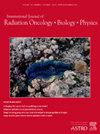INNATE:直肠癌新辅助治疗期间索替加利单抗免疫疗法随机II期试验的结果和免疫反应
IF 6.4
1区 医学
Q1 ONCOLOGY
International Journal of Radiation Oncology Biology Physics
Pub Date : 2024-10-01
DOI:10.1016/j.ijrobp.2024.08.019
引用次数: 0
摘要
目的/目标:免疫疗法对非选择性结直肠癌的疗效尚未显现。材料/方法INNATE(NCT04130854)是一项针对III期或高危II期LARD患者的多机构II期随机试验。患者以3:2的比例随机接受每日SCRT(5 Gy x 5)和6个周期的FOLFOX治疗以及6次索替加输注,然后按分期进行全直肠系膜切除术。收集肿瘤组织,包括SCRT前后的组织,用于单细胞RNA测序和多重免疫荧光。结果从 20 年 7 月 30 日到 22 年 6 月 23 日,4 个中心共招募了 30 名患者(19 名患者随机接受 Sotiga 治疗),之后招募工作暂停。患者病情不乐观:所有患者均为 T3/4,20 例(67%)为 N2 病变,21 例(70%)肿瘤累及或威胁到直肠系膜筋膜。在接受 TME 的 26 名患者中,研究组有 4/18(22.2%)人获得了 pCR,对照组有 1/7(14.3%)人获得了 pCR。7/19(36.8%)名研究组患者和 6/10(60%)名对照组患者获得了 pCR、接近 CR 或持续 12 个月临床 CR 的主要反应。治疗前和治疗后的平均放射轮廓肿瘤体积分别为研究组为 52.2 毫升(标度 = 34.39)和 11.05 毫升(-78.82%),对照组为 36.46 毫升(标度 = 29.34)和 16.77 毫升(-54.00%)。5名研究组患者(26%)和5名对照组患者(45%)出现了3-4级毒性反应。最常见的毒性反应为3级消化道相关反应(7例)、感染(5例)和血栓栓塞(2例)。其他毒性反应包括腹痛、直肠瘘、放射性直肠炎和穿孔(n=1ea)。研究组有1例4级(无关)术后口腔穿孔,对照组有1例5级败血症和CT期间穿孔后心脏骤停。SCRT 术前术后比较显示,两组抗原递呈细胞浸润均显著增加(FDR < 0.05)。SCRT(P = 0.01)后抗肿瘤 M1 巨噬细胞特征较高,SCRT+Sotiga(P = 5.74e-08)更明显。SCRT和SCRT+Sotiga后,1型树突状细胞活化和抗原递呈途径以及CD40信号传导显著增加。抗肿瘤效应延伸至 T 细胞,CD8 T 细胞(IL-2、GZMB、GZMK、NKG7)和 NK 细胞(PRF1、GZMB)的细胞毒活性增加。结论:在LARC的SCRT和CT中加入索替加似乎是安全的,并能对不利疾病产生强有力的反应,与单用SCRT相比,有证据表明抗肿瘤适应性免疫反应增强。疾病控制结果待定。本文章由计算机程序翻译,如有差异,请以英文原文为准。
Outcomes and Immune Responses from INNATE: A Randomized Phase II Trial of Sotigalimab Immunotherapy during Neoadjuvant Therapy of Rectal Cancer
Purpose/Objective(s)
Immunotherapy benefit has yet to show benefit in unselected colorectal cancer. The addition of a CD40 agonist, sotigalimab (Sotiga), to short course radiotherapy (SCRT) and FOLFOX chemotherapy (CT) is hypothesized to improve pathologic complete response (pCR) in locally advanced rectal cancer (LARC).
Materials/Methods
INNATE (NCT04130854) is a multi-institutional Phase II randomized trial for patients with Stage III or high-risk Stage II LARD. Patients were randomized 3:2 to receive daily SCRT (5 Gy x 5) and 6 cycles of FOLFOX ± 6 infusions of Sotiga, followed by total mesorectal excision stratified by stage. Tumor tissue was collected including pre- and post-SCRT for single cell RNA sequencing and multiplex immunofluorescence. Target accrual was 58 patients with the primary pCR endpoint powered for a 22% difference.
Results
From 7/30/20 to 6/23/22, 30 patients were enrolled by 4 centers (19 randomized to Sotiga), after which accrual was held. Patients had unfavorable disease: all were T3/4, 20 (67%) had N2 disease and 21 (70%) had tumor involving or threatening the mesorectal fascia. Of 26 patients that underwent TME, pCR was achieved in 4/18 (22.2%) in the study arm and 1/7 (14.3%) in the control arm. Major response of pCR, near CR, or sustained 12-month clinical CR occurred in 7/19 (36.8%) in the study arm and 6/10 (60%) control arm patients. Average radiology contoured tumor volumes pre- and post-treatment were respectively: 52.2 cc (SD = 34.39) and 11.05 cc (-78.82%) in the study arm, and 36.46 cc (SD = 29.34) 16.77 cc (-54.00 %) in control arm. Grade 3-4 toxicities occurred in 5 (26%) study arm patients and 5 (45%) control arm patients. The most common toxicities were Grade 3 GI related (n=7), infection (n=5), and thromboembolism (n=2). Other toxicities included abdominal pain, rectal fistula, radiation proctitis, and perforation (n=1ea). The study arm had 1 Grade 4 (unrelated) postoperative stercoral perforation, and the control arm had a Grade 5 sepsis and cardiac arrest after perforation during CT. Comparisons pre-post SCRT revealed significant increases in infiltration of antigen-presenting cells in both arms (FDR < 0.05). Higher anti-tumor M1 macrophage signature after SCRT (p = 0.01) was more pronounced with SCRT+Sotiga (p = 5.74e-08). Type 1 dendritic cell activation and antigen presentation pathways and CD40 signaling were significantly increased after SCRT and SCRT+Sotiga. Anti-tumor effects extended to T cells, with increased cytotoxic activity in CD8 T cells (IL-2, GZMB, GZMK, NKG7) and NK cells (PRF1, GZMB). Expression of immune checkpoints shifted in each arm suggesting additional targets for combination therapy with SCRT or Sotiga.
Conclusion
Adding Sotiga to SCRT and CT in LARC appears to be safe and shows robust responses to unfavorable disease, with evidence of increased antitumor adaptive immune responses compared to SCRT alone. Disease control outcomes are pending.
求助全文
通过发布文献求助,成功后即可免费获取论文全文。
去求助
来源期刊
CiteScore
11.00
自引率
7.10%
发文量
2538
审稿时长
6.6 weeks
期刊介绍:
International Journal of Radiation Oncology • Biology • Physics (IJROBP), known in the field as the Red Journal, publishes original laboratory and clinical investigations related to radiation oncology, radiation biology, medical physics, and both education and health policy as it relates to the field.
This journal has a particular interest in original contributions of the following types: prospective clinical trials, outcomes research, and large database interrogation. In addition, it seeks reports of high-impact innovations in single or combined modality treatment, tumor sensitization, normal tissue protection (including both precision avoidance and pharmacologic means), brachytherapy, particle irradiation, and cancer imaging. Technical advances related to dosimetry and conformal radiation treatment planning are of interest, as are basic science studies investigating tumor physiology and the molecular biology underlying cancer and normal tissue radiation response.

 求助内容:
求助内容: 应助结果提醒方式:
应助结果提醒方式:


